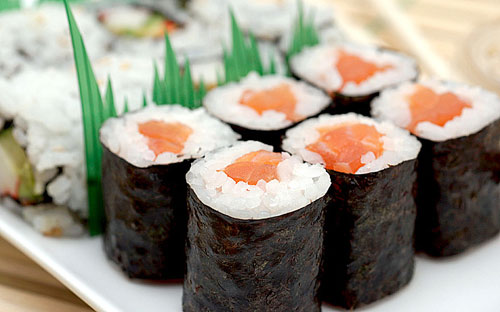|
Sushi prices in restaurants and supermarkets are tipped to soar after a sharp increase in one of the key costs of creating the Japanese dish.
A large proportion of sushi, which combines raw fish or vegetables with cooked vinegared rice, contains farmed shrimp, prawns or salmon.
The cost of the main feed for farmed fish has jumped by almost 50 percent in two weeks to reach a record high, according to reports.
The feed, called fishmeal, is a brown powder made from dried fish bones and the trimmings of small marine species such as anchovies.
Rising sea temperatures led to a drop in anchovy catches in Peru, the world's largest exporter, pushing up prices. A tonne of fishmeal now costs $2,500, according to the Financial Times, up from $1,689 at the end of October.
Fishmeal prices have risen fourfold in a decade due to climate change and increased demand, with around four per cent more farmed fish being eaten every year.
The increased costs are expected to be passed on to diners as restaurants and cafés serving sushi put up prices to maintain their margins.
The most popular sushi consist of raw, prawns, salmon and shrimp and rice. Most of the raw fish is farmed.
The growth of sushi, which has become fashionable in Britain and other western nations over the past few years, and the general popularity of fish this year led to global farmed fish consumption surpassing that of "captured" fish for the first time. |
在日食的制作成本增加后,餐馆及超市的寿司价格也将水涨船高。
大部分寿司都是用生鱼肉或蔬菜搭配上醋饭制作而成,其馅料有养殖的小虾、明虾或三文鱼。
据报道,养殖鱼类的主要饲料造价在两星期内上涨了50%,达到历史新高。
这种饲料又被叫做鱼粉(fishmeal),是用干燥的鱼骨和凤尾鱼等小型海洋生物制成的褐色粉末。
海水温度上升导致秘鲁(Peru)的凤尾鱼捕捞量减少,作为世界第一大鱼粉出口国,秘鲁抬高了其价格。据《金融时报》(Financial Times)报导,今年10月末,一吨鱼粉的价格由1689美元(约人民币1.03万元)上涨至2500美元(人民币1.53万元)。
由于气候变化及需求增加,鱼粉的价格已经在十年内上涨了四倍,而每年超过百分之四的鱼粉都用于渔业养殖。
预计成本增加将间接影响到食客们,因为餐馆和供应寿司的咖啡馆会提高价格以维持利润。
人气寿司的制作原料包括生鱼肉、明虾、三文鱼、小虾和米饭,其中大部分生鱼肉都来自养殖鱼类。
在过去几年中,寿司在英国和其他西方国家已成为时尚。由于今年寿司及其他鱼产品广受欢迎,全球养殖鱼类消费量首次超过了“捕获”鱼类。
(译者 zoe212 编辑 丹妮)
扫一扫,关注微博微信
 
|

